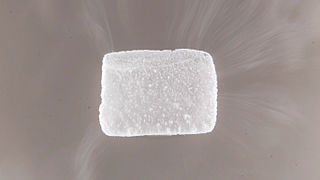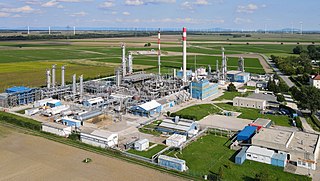



Bottled gas is a term used for substances which are gaseous at standard temperature and pressure (STP) and have been compressed and stored in carbon steel, stainless steel, aluminum, or composite containers known as gas cylinders.[ citation needed ]




Bottled gas is a term used for substances which are gaseous at standard temperature and pressure (STP) and have been compressed and stored in carbon steel, stainless steel, aluminum, or composite containers known as gas cylinders.[ citation needed ]
There are four cases: either the substance remains a gas at standard temperature but increased pressure, the substance liquefies at standard temperature but increased pressure, the substance is dissolved in a solvent, or the substance is liquefied at reduced temperature and increased pressure. In the last case the bottle is constructed with an inner and outer shell separated by a vacuum (dewar flask) so that the low temperature can be maintained by evaporative cooling.[ citation needed ]
The substance remains a gas at standard temperature and increased pressure, its critical temperature being below standard temperature. Examples include:
The substance liquefies at standard temperature but increased pressure. Examples include:[ citation needed ]
The substance is dissolved at standard temperature in a solvent. Examples include:
The substance is liquefied at reduced temperature and increased pressure. These are also referred to as cryogenic gases. Examples include:[ citation needed ]
The general rule is that one unit volume of liquid will expand to approximately 800 unit volumes of gas at standard temperature and pressure with some variation due to intermolecular force and molecule size compared to an ideal gas. Normal high pressure gas cylinders will hold gas at pressures from 200 to 400 bars (3,000 to 6,000 psi). An ideal gas pressurised to 200 bar in a cylinder would contain 200 times as much as the volume of the cylinder at atmospheric pressure, but real gases will contain less than that by a few percent. At higher pressures, the shortfall is greater.
Because the contents are under high pressure and are sometimes hazardous, there are special safety regulations for handling bottled gases. These include chaining bottles to prevent falling and breaking, proper ventilation to prevent injury or death in case of leaks and signage to indicate the potential hazards.
In the United States, the Compressed Gas Association (CGA) sells a number of booklets and pamphlets on safe handling and use of bottled gases. (Members of the CGA can get the pamphlets for free.) The European Industrial Gases Association and the British Compressed Gases Association provide similar facilities in Europe and the United Kingdom.
In the United States, 'bottled gas' typically refers to liquefied petroleum gas. 'Bottled gas' is sometimes used in medical supply, especially for portable oxygen tanks. Packaged industrial gases are frequently called 'cylinder gas', though 'bottled gas' is sometimes used.
The United Kingdom and other parts of Europe more commonly refer to 'bottled gas' when discussing any usage whether industrial, medical or liquefied petroleum. However, in contrast, what the United States calls liquefied petroleum gas is known generically in the United Kingdom as 'LPG'; and it may be ordered using by one of several Trade names, or specifically as butane or propane depending on the required heat output.
Different countries have different gas colour codes but attempts are being made to standardise the colours of cylinder shoulders:[ citation needed ]
The user should not rely on the colour of a cylinder to indicate what it contains. The label or decal should always be checked for product identification.
The colours below are specific shades, defined in the European Standard [1] [2] [3] in terms of RAL coordinates. The requirements are based on a combination of a few named gases, otherwise on the primary hazard associated with the gas contents:
| Gas | Colour | RAL | Notes | |
|---|---|---|---|---|
| Acetylene | maroon | 3009 | ||
| Argon | dark green shoulder | 6001 | ||
| Carbon dioxide | grey shoulder | 7037 | ||
| Chlorine | yellow shoulder | 1018 | ||
| Helium | brown shoulder | 8008 | ||
| Hydrogen | red shoulder | 3000 | ||
| Nitrous oxide | blue shoulder | 5010 | ||
| Nitrogen | black shoulder | 9005 | previously grey in the UK | |
| Oxygen | white shoulder | 9010 | previously black in the UK | |
| Gas property | Colour | Examples | ||
|---|---|---|---|---|
| Toxic or corrosive | yellow shoulder | ammonia, chlorine, fluorine, arsine, carbon monoxide, sulfur dioxide | ||
| Flammable | red shoulder | hydrogen, methane, ethylene, forming gas | ||
| Oxidising | light blue shoulder | nitrous oxide, oxygen-containing blends | ||
| Inert (nontoxic, nonflammable, nonoxidising) | bright green | neon, krypton, xenon | ||
| Toxic and flammable or Toxic and corrosive | yellow and red shoulders (either two bands or quartered) | |||
| Toxic and oxidising or Corrosive and oxidising | yellow and light blue shoulders (either two bands or quartered) | |||
Diving cylinders are left unpainted (for aluminium), or painted to prevent corrosion (for steel), often in bright colors, most often fluorescent yellow, to increase visibility. This should not be confused with industrial gases, where a yellow shoulder means chlorine.
| Gas | Colour | Alternative | |||||
|---|---|---|---|---|---|---|---|
| Air | white and black quartered shoulder or white top and black band | ||||||
| Nitrox mixture of nitrogen and oxygen | white and black quartered shoulder or white top and black band | green stripe on yellow bottom | |||||
| Heliox mixture of helium and oxygen | white and brown quartered shoulder | ||||||
| Trimix mixture of helium, nitrogen and oxygen | white, black and brown segmented shoulder | ||||||

Nitrogen is a chemical element; it has symbol N and atomic number 7. Nitrogen is a nonmetal and the lightest member of group 15 of the periodic table, often called the pnictogens. It is a common element in the universe, estimated at seventh in total abundance in the Milky Way and the Solar System. At standard temperature and pressure, two atoms of the element bond to form N2, a colorless and odorless diatomic gas. N2 forms about 78% of Earth's atmosphere, making it the most abundant uncombined element in air. Because of the volatility of nitrogen compounds, nitrogen is relatively rare in the solid parts of the Earth.

Propane is a three-carbon alkane with the molecular formula C3H8. It is a gas at standard temperature and pressure, but compressible to a transportable liquid. A by-product of natural gas processing and petroleum refining, it is commonly used as a fuel in domestic and industrial applications and in low-emissions public transportation. Discovered in 1857 by the French chemist Marcellin Berthelot, it became commercially available in the US by 1911. Propane is one of a group of liquefied petroleum gases. The others include propylene, butane, butylene, butadiene, isobutylene, and mixtures thereof. Propane has lower volumetric energy density, but higher gravimetric energy density and burns more cleanly than gasoline and coal.

Dry ice is the solid form of carbon dioxide. It is commonly used for temporary refrigeration as CO2 does not have a liquid state at normal atmospheric pressure and sublimes directly from the solid state to the gas state. It is used primarily as a cooling agent, but is also used in fog machines at theatres for dramatic effects. Its advantages include lower temperature than that of water ice and not leaving any residue (other than incidental frost from moisture in the atmosphere). It is useful for preserving frozen foods (such as ice cream) where mechanical cooling is unavailable.

Liquid nitrogen—LN2—is nitrogen in a liquid state at low temperature. Liquid nitrogen has a boiling point of about −196 °C (−321 °F; 77 K). It is produced industrially by fractional distillation of liquid air. It is a colorless, mobile liquid whose viscosity is about one tenth that of acetone. Liquid nitrogen is widely used as a coolant.

A breathing gas is a mixture of gaseous chemical elements and compounds used for respiration. Air is the most common and only natural breathing gas, but other mixtures of gases, or pure oxygen, are also used in breathing equipment and enclosed habitats such as scuba equipment, surface supplied diving equipment, recompression chambers, high-altitude mountaineering, high-flying aircraft, submarines, space suits, spacecraft, medical life support and first aid equipment, and anaesthetic machines.
A supercritical fluid (SCF) is any substance at a temperature and pressure above its critical point, where distinct liquid and gas phases do not exist, but below the pressure required to compress it into a solid. It can effuse through porous solids like a gas, overcoming the mass transfer limitations that slow liquid transport through such materials. SCF are superior to gases in their ability to dissolve materials like liquids or solids. Also, near the critical point, small changes in pressure or temperature result in large changes in density, allowing many properties of a supercritical fluid to be "fine-tuned".

Liquid fuels are combustible or energy-generating molecules that can be harnessed to create mechanical energy, usually producing kinetic energy; they also must take the shape of their container. It is the fumes of liquid fuels that are flammable instead of the fluid. Most liquid fuels in widespread use are derived from fossil fuels; however, there are several types, such as hydrogen fuel, ethanol, and biodiesel, which are also categorized as a liquid fuel. Many liquid fuels play a primary role in transportation and the economy.
Liquid air is air that has been cooled to very low temperatures, so that it has condensed into a pale blue mobile liquid. It is stored in specialized containers, such as vacuum flasks, to insulate it from room temperature. Liquid air can absorb heat rapidly and revert to its gaseous state. It is often used for condensing other substances into liquid and/or solidifying them, and as an industrial source of nitrogen, oxygen, argon, and other inert gases through a process called air separation.

A gas cylinder is a pressure vessel for storage and containment of gases at above atmospheric pressure. High-pressure gas cylinders are also called bottles. Inside the cylinder the stored contents may be in a state of compressed gas, vapor over liquid, supercritical fluid, or dissolved in a substrate material, depending on the physical characteristics of the contents. A typical gas cylinder design is elongated, standing upright on a flattened bottom end, with the valve and fitting at the top for connecting to the receiving apparatus.
Degassing, also known as degasification, is the removal of dissolved gases from liquids, especially water or aqueous solutions. There are numerous methods for removing gases from liquids.

Pressure swing adsorption (PSA) is a technique used to separate some gas species from a mixture of gases under pressure according to the species' molecular characteristics and affinity for an adsorbent material. It operates at near-ambient temperature and significantly differs from the cryogenic distillation commonly used to separate gases. Selective adsorbent materials are used as trapping material, preferentially adsorbing the target gas species at high pressure. The process then swings to low pressure to desorb the adsorbed gas.

Liquefaction of gases is physical conversion of a gas into a liquid state (condensation). The liquefaction of gases is a complicated process that uses various compressions and expansions to achieve high pressures and very low temperatures, using, for example, turboexpanders.

Industrial gases are the gaseous materials that are manufactured for use in industry. The principal gases provided are nitrogen, oxygen, carbon dioxide, argon, hydrogen, helium and acetylene, although many other gases and mixtures are also available in gas cylinders. The industry producing these gases is also known as industrial gas, which is seen as also encompassing the supply of equipment and technology to produce and use the gases. Their production is a part of the wider chemical Industry.
The expansion ratio of a liquefied and cryogenic substance is the volume of a given amount of that substance in liquid form compared to the volume of the same amount of substance in gaseous form, at room temperature and normal atmospheric pressure.

Natural-gas processing is a range of industrial processes designed to purify raw natural gas by removing contaminants such as solids, water, carbon dioxide (CO2), hydrogen sulfide (H2S), mercury and higher molecular mass hydrocarbons (condensate) to produce pipeline quality dry natural gas for pipeline distribution and final use. Some of the substances which contaminate natural gas have economic value and are further processed or sold. Hydrocarbons that are liquid at ambient conditions: temperature and pressure (i.e., pentane and heavier) are called natural-gas condensate (sometimes also called natural gasoline or simply condensate).
The Glossary of fuel cell terms lists the definitions of many terms used within the fuel cell industry. The terms in this fuel cell glossary may be used by fuel cell industry associations, in education material and fuel cell codes and standards to name but a few.

Nitrogen generators and stations are stationary or mobile air-to-nitrogen production complexes.
An air separation plant separates atmospheric air into its primary components, typically nitrogen and oxygen, and sometimes also argon and other rare inert gases.

A cryogenic gas plant is an industrial facility that creates molecular oxygen, molecular nitrogen, argon, krypton, helium, and xenon at relatively high purity. As air is made up of nitrogen, the most common gas in the atmosphere, at 78%, with oxygen at 19%, and argon at 1%, with trace gasses making up the rest, cryogenic gas plants separate air inside a distillation column at cryogenic temperatures to produce high purity gasses such as argon, nitrogen, oxygen, and many more with 1 ppm or less impurities. The process is based on the general theory of the Hampson-Linde cycle of air separation, which was invented by Carl von Linde in 1895.
The Liquid Nitrogen Wash is mainly used for the production of ammonia synthesis gas within fertilizer production plants. It is usually the last purification step in the ammonia production process sequence upstream of the actual ammonia production.